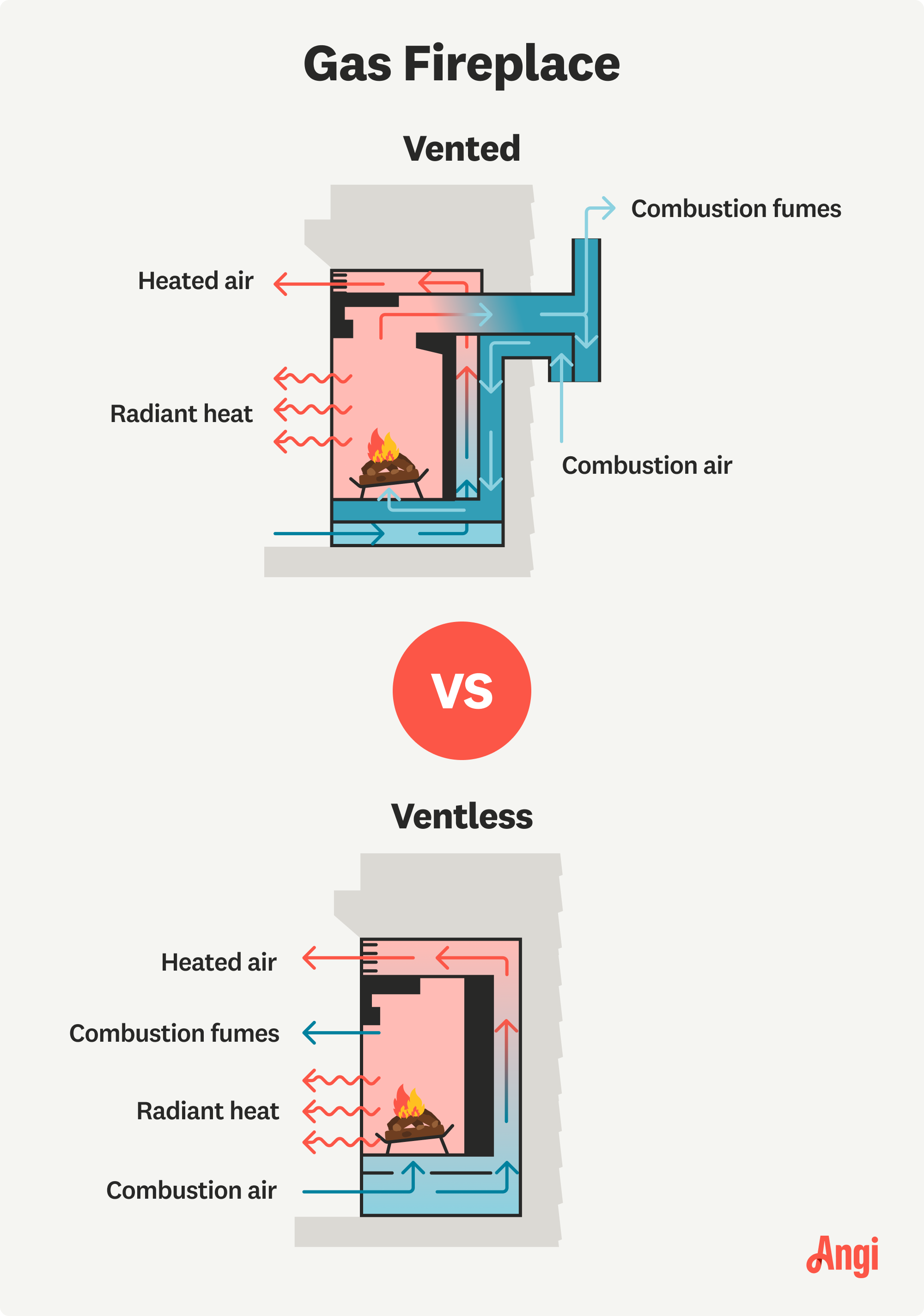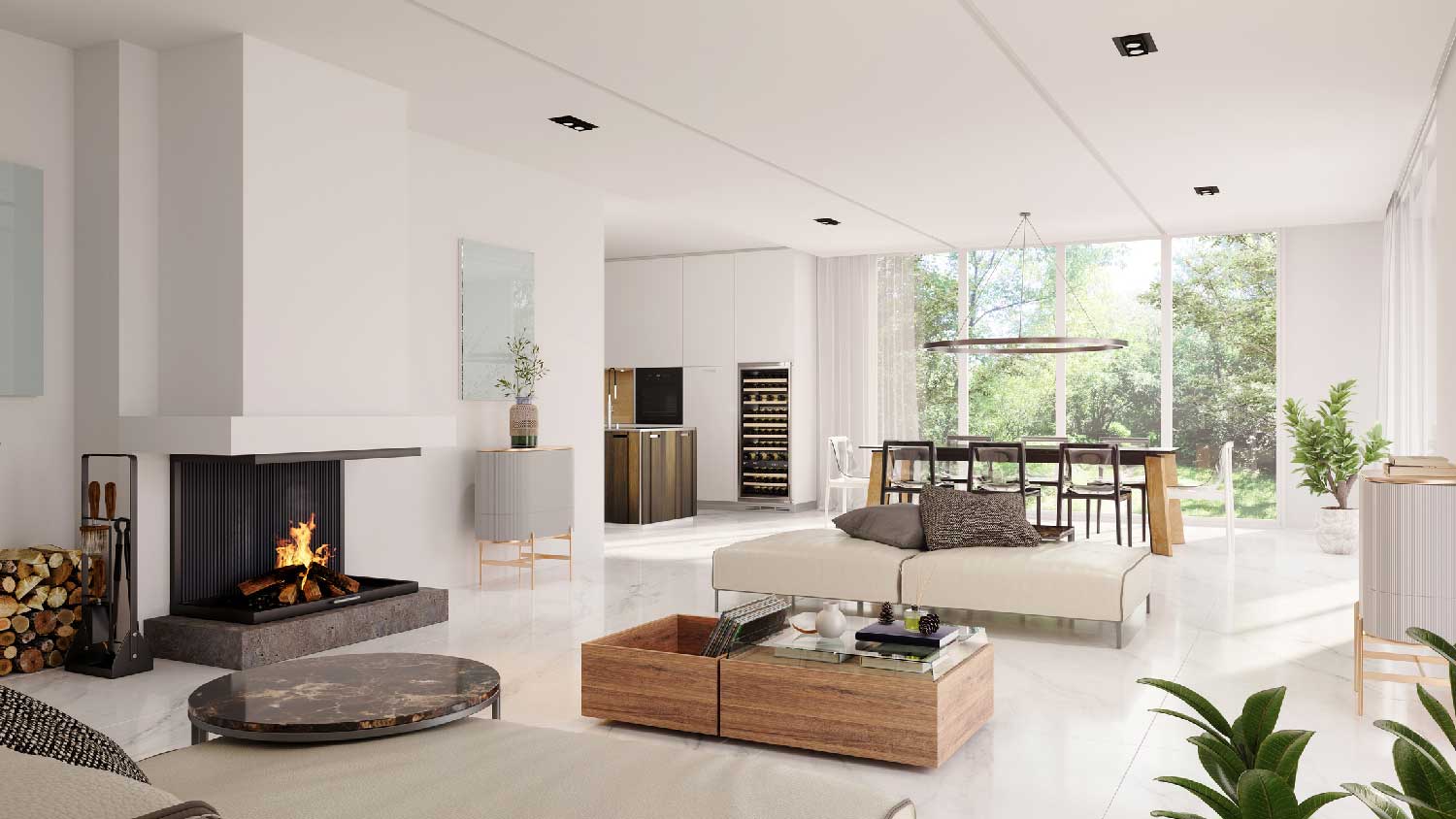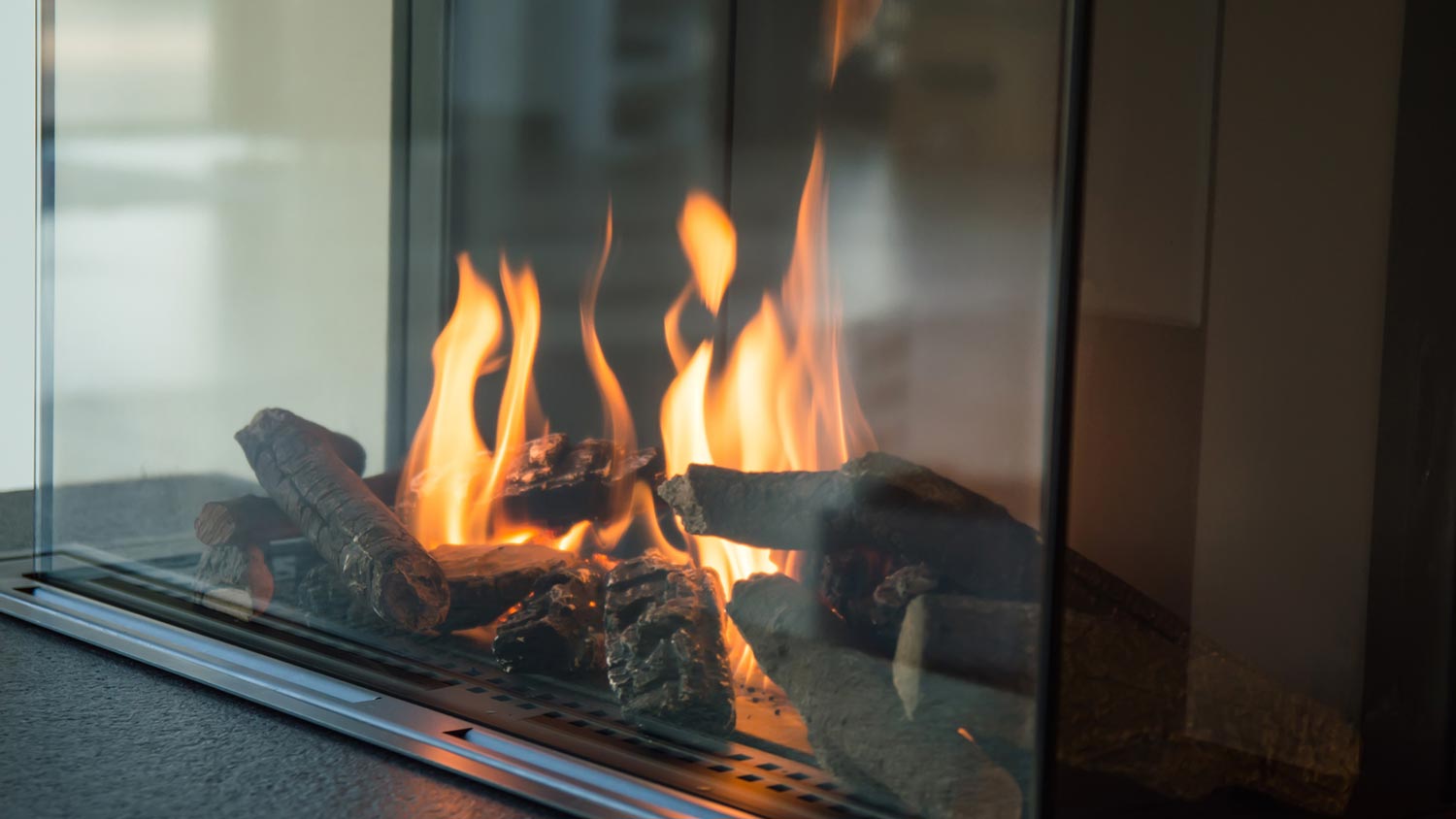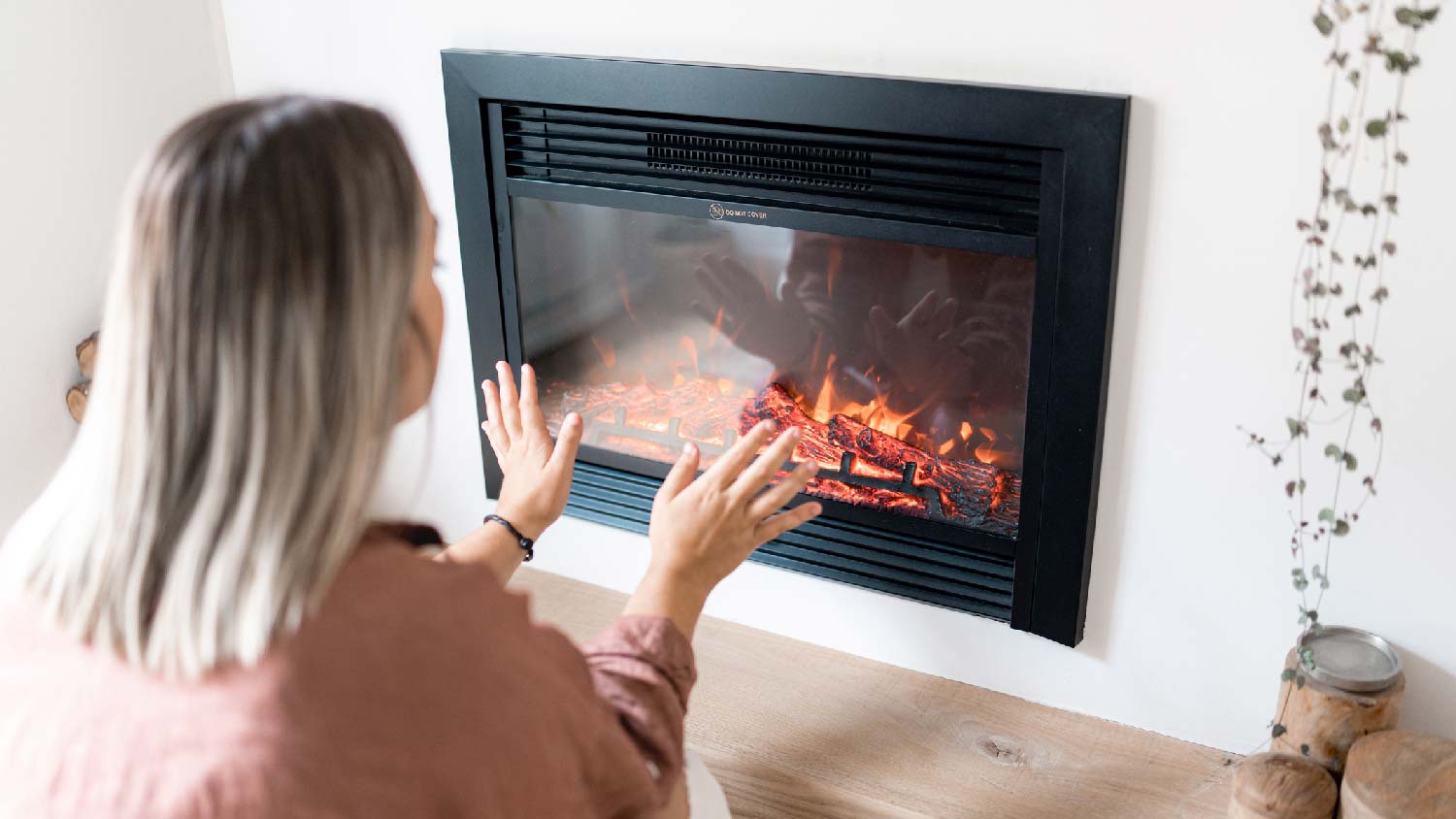
The average fireplace installation cost is $2,438, but prices vary depending on the type and size of the fireplace. Calculate your costs with our guide.
Let’s dive into this hot topic


Vented fireplaces need a chimney or vent to push combustion byproducts outside.
Ventless fireplaces don’t require a chimney because their emissions stay in the home.
Vented fireplaces are more expensive to install and less efficient than ventless models.
Due to safety concerns, ventless gas fireplaces are banned in some places.
Ventless gas fireplaces start at $800, while vented fireplaces begin around $1,700.
They might not have the cozy charm of a wood-burning fireplace, but gas fireplaces are a more convenient (and less messy) alternative. If you pick this type of fireplace, you’ll need to decide whether you prefer a vented or ventless model. Not sure what the difference is? Read on to discover the basics of each type and figure out when it’s best to install a ventless versus a vented gas fireplace.

When it comes to vented versus ventless fireplaces, one of the biggest differences is how they pull in air. Vented gas fireplaces draw in air from the outside of your home, then exhaust the smoke and fumes through a chimney or vent. Ventless gas fireplaces connect to a gas line rather than a chimney. To warm your home, they pull in indoor air and exhaust it back out as heat.
| Ventless Gas Fireplaces | Vented Gas Fireplaces |
|---|---|
| Combustion byproducts are minimal and stay in your home | Combustion byproducts are vented outside |
| Heat radiates into your living space | Lose some heat through the chimney |
| More affordable | More expensive to install and run |
| Not legal in all areas | Produce more lively fires |

A vented gas fireplace requires a chimney or vent to bring in outdoor air for combustion and then expel gas, smoke, and excess heat from your home. This setup ensures that the byproducts of combustion don’t get into your home or impact your indoor air quality. Unlike traditional wood-burning fireplaces, vented gas fireplaces don’t use firewood. They often have ceramic logs or glass beads instead.
| Pros | Cons |
|---|---|
| Considered safer than ventless fireplaces | More expensive to run and maintain |
| Don’t affect indoor air quality | Require a chimney or vent |
| Flames look more realistic | Less energy-efficient |
Best for:
Homes with existing chimneys or venting systems
People who want the look of a wood-burning fireplace without the mess
Individuals with allergies, asthma, or respiratory conditions
With a vented gas fireplace, all of the potentially harmful byproducts of combustion—including carbon monoxide and particulate matter—escape through the chimney. This is safer for your health and doesn’t impact the air quality inside your home, according to a study conducted by the U.S. Environmental Protection Agency (EPA).
From an aesthetic perspective, vented gas fireplaces tend to produce larger fires than ventless models. These fires also appear more natural, creating the type of flickering flames you’d get from a traditional wood-burning fire.
One of the main downsides of vented gas fireplaces is that you need a chimney or vent to install one. On top of that, they’re less efficient than their ventless counterparts. Vented fireplaces burn through more fuel and allow heat to escape through the chimney, which can increase your gas fireplace operating expenses.
Similarly, vented gas fireplaces cost more to install than ventless versions—especially if your chimney needs work. Speaking of chimneys, you’ll also have to factor in the cost of chimney inspections and maintenance, which can add up to hundreds or thousands of dollars per year.

A ventless or vent-free gas fireplace hooks up to a gas line to provide heating for your home without using a chimney or vent. It combusts air from inside your home, then pushes the heat out into the room it’s in. With no external venting, these fireplaces release the residual byproducts from combustion into your home, which can create safety hazards and air quality issues. As a result, the installation of ventless gas fireplaces is not permitted in some parts of the country.
| Pros | Cons |
|---|---|
| Don’t need a chimney or vent | Banned in certain areas |
| Can be installed in more parts of your home | May increase condensation in your home |
| Heat remains in your house | Can’t run for long periods |
Best for:
Homes or apartments without chimneys
Anyone who wants a highly efficient gas fireplace
People looking for a more affordable alternative to traditional vented gas fireplaces
Because ventless gas fireplaces don’t require venting, you can install this fireplace without a chimney. This is useful if your home doesn’t have a chimney or you’d like to add a fireplace in a room without a chimney. It also simplifies the installation process.
Another benefit of ventless gas fireplaces is that they’re energy efficient. The warmth they generate stays inside your home, and there’s no heat loss through your chimney.
Don’t get your heart set on a ventless gas fireplace until you check the laws in your area. According to the International Association of Home Inspectors (InterNACHI), these fireplaces are outlawed in some cities and states, including California, because they emit combustion byproducts into the home. Even though the emission levels are minimal, they can trigger health problems in people with allergies, asthma, or respiratory conditions.
If you have a gas appliance, install carbon monoxide alarms on every level of your home, in central locations, and outside bedrooms. Check all of your carbon monoxide detectors every month, and replace the batteries on a set schedule according to the manufacturer’s instructions.
Vent-free gas fireplaces also produce water vapor as they run. Without proper ventilation, this moisture can collect inside your home, potentially leading to issues with mold and mildew. You may be able to prevent this by limiting how often you run the fireplace and opening a window while the fire is burning.
The majority of residential fireplace projects involve hiring a pro to replace or alter an existing fireplace. The second most popular project is the installation of a new fireplace. The choice between a vented and ventless fireplace could affect whether you want to remodel your fireplace or install a new one. For example, you’ll need a chimney to run a vented fireplace, while ventless fireplaces are more efficient and fit into more spaces—but they’re prohibited in some areas.
A gas fireplace professional can advise on the best option for your home and safely install it.

Here’s how vented versus ventless gas fireplaces compare in key categories like price and safety.
Vented gas fireplaces are pricier to install than ventless fireplaces, largely because they require a chimney or vent connection. On average, a ventless gas fireplace costs $800 to $2,600, while a vented fireplace costs between $1,700 and $12,500.
Vented gas fireplaces are safer because all of their emissions leave your home. In contrast, the safety of ventless fireplaces is hotly debated since they exhaust directly into living spaces.
Each type of fireplace offers some type of flexibility. For example, vented models can be vented through a chimney or exterior wall, while ventless versions can be installed in many places, including the middle of a room. Both kinds come in numerous sizes, shapes, and finishes and can be paired with different logs and decorative elements.
From average costs to expert advice, get all the answers you need to get your job done.

The average fireplace installation cost is $2,438, but prices vary depending on the type and size of the fireplace. Calculate your costs with our guide.

With a gas fireplace, it’s important to stay up-to-date on your inspections. Learn more about how much gas fireplace inspections cost before you book one.

This guide shares information about the cost to remove a gas fireplace, including the average price to additionally remove the breast, stack, and chimney flue as well as which experts will be needed to complete the project.

If you’re preparing to add the beauty and warmth of a new fireplace, here are the brick or stone fireplace questions to ask surrounding their installation.

Ready for a fireplace upgrade? Here’s how to install a wood-burning fireplace insert for increased efficiency and toastier nights in front of the fire.

Is your electric fireplace acting up? Troubleshoot seven of the most common electric fireplace problems with this guide.